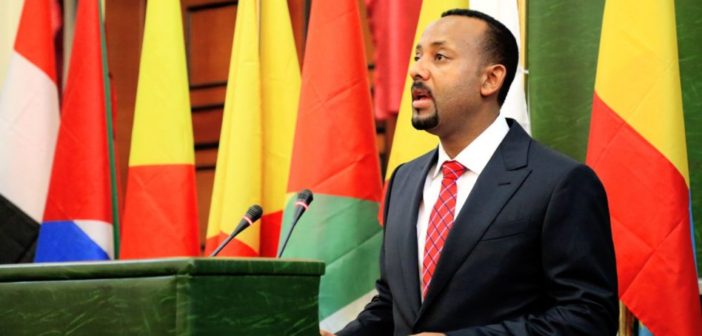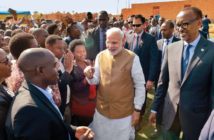There are decades where nothing happens; and there are weeks where decades happen- Vladimir Lenin (1870-1924)
Ethiopia is Africa’s second most populous country after Nigeria. Astonishingly the youth accounts for about 70 % of the total population.[1] The Ethiopian People’s Revolutionary Democratic Front (EPRDF), a coalition of four regionally and ethnically representative parties[2], came to power in Ethiopia in 1991 by overthrowing the communist regime. Meles Zenawi (1955-2012) from TPLF was elected the president of Transitional Government in 1991 and in the general elections of 1995, he become the first prime minister of the Federal Democratic Republic of Ethiopia (FDRE) selected by the parliament after winning a resounding victory.[3] After he became prime minister, in theory he opted for multi-party system and Revolutionary Democracy. However, in fact he emerged as a dictator and FDRE under him was a one party totalitarian state. The EPRDF monopolised economy and political affairs, and marginalised opposition parties by imprisoning its leaders. Meles died on 20 August, 2012 and succeed by Deputy Prime Minister Haile Mariam Dessalegn from SEPDM and Haile Mariam remained on power until his surprise resignation on 15 February, 2018. Haile Mariam was not as strong as his predecessor however; the EPRDF maintained its status quo where the real power vested in the hands of TPLF. In the past two decades Ethiopia is listed among the world’s top ten internet oppressors, total ban of the private media press, detention and imprisonment of journalists and bloggers.[4]
The economy is controlled by a few government affiliated organisation where the majority led substance way of life. Land grabbing in Oromia region become common where farmers were evicted without enough compensation.[5] It is in response to such suppression, that the anti-government protest led by the Oromo youth popularly known as the Qerro, vanguard of the Oromo revolution, began in December, 2015 at Ginchi ,Ambo town. Ambo is located in central Ethiopia which became the epicentre of the protest in Oromia.[6]
On April, 02, 2018 Abiy Ahmed Ali (PhD), the 42-year-old, comes from a mixed Christian-Muslim family-former army officer from among OPDO, selected prime minister by the parliament. Since he took office, he was moving at the lightning speed, though for some still the expected results are not attained.[7]
In the four months since Abiy, he has riveted this East African nation with announcements that have shattered political taboos. He has engaged in a series of national and international visits and held discussion with the concerned bodies for reconciliation and to bring lasting peace.[8]
Accordingly,
03 April, 2018 he held discussion with African Union in Addis Ababa.
04 April, 2018 he held discussion with the Egyptian president Abdel Fatah al-Sisi.
06 April, 2018 he closed the Ethiopian notorious prison centre called Maikelewi.
07 April, 2018 he visited Somali region of Ethiopia and held discussion in Jijiga town.
10 April, 2018 he met Kenyan foreign minister and discussed the bilateral relations.
12 April, 2018, he visited Ambo town, epicentre of Oromo protests (2014- 2018).
13 April, 2018, he visited Tigray region and held public discussion in Mekele town.
15 April, 2018 he held discussion with representatives from all parts in Addis Ababa.
16 April, 2018 he discussed with business organisations, leaders and persons.
18 April, 2018 he received and held discussion with the Saudi Arabia delegates.
19 April, 2018 he appointed new cabinets by removing most of the old ones.
20 April, 2018 he held discussion with the people of Amhara region in Gonder town.
21 April, 2018 he held discussion with the people of Amhara region in Bahr Dar town.
22 April, 2018 he participated on Tana High-level Forum on Peace in Ethiopia, Bahr Dar.
24, April, 2018 he awarded state hero his immediate predecessor, Haile Mariam Desalegn.
26 April, 2018 he held discussion with the people of Hawassa town (Southern Nations).
28 April 2018 he visited Djibouti and held discussion with country’s president.
01 May, 2018 he visited Grand Ethiopian Renaissance Dam underway on Abay River.
02 May, 2018 he visited Sudan, Khartoum and met President Omar Hassan al-Bashir.
05 May, 2018 he visited and held discussion with Bale zone, Southern Oromia residents.
06 May, 2018 he made his third overseas trip to Kenya, preceded by Djibouti and Sudan.
10 May, 2018 he welcomed China’s top legislator Li Zhanshu who visited Ethiopia.
15 May, 2018 he trained newly elected ministers on different socio-economic affairs.
16 May, 2018 he ordered the arrest of 13 top government officials suspected of corruption.
17 May, 2018 he visited Saudi Arabia, upon invitation from King Salman bin Abdulaziz.
18 May, 2018 he visited Abu Dhabi and held discussion with Sheikh Mohammed Zayed.
20 May, 2018 he visited western Oromia region-Dembi Dollo another centre of protest.
21 May, 2018 he visited Gambella region and held discussion with people on peace.
23 May, 2018 he held discussion with five leaders of Oromo Democratic Front (OLF).
25 May, 2018 he received and discussed with Rwandan President Paul Kagame.
27 May,2018 he delivered a speech on the May 28 National Victory (end of Derg regime).
28 May, 2018 he released Andargachew Tsige, member of the Patriot Ginbot 7 (PG7).
30 May, 2018 he held a meeting with Andargachew Tsige, who was released from jail.
30 May, 2018 he held discussion with President Salva Kiir Mayardit of South Sudan.
01 June, 2018 he gave training to the leaders of Defense Force and military sections.
02 June, 2018 he endorsed his cabinet to approve the lifting of the state of emergency.
06 June, 2018 he announced the implementation of the 2000 Algiers Peace Agreement.
07 June, 2018 he appointed General Seare Mekonnen as chief of National Defense Forces.
08 June, 2018 he visited Uganda and met President Yoweri Museveni.
09, June, 2018, he received Pearl of Africa Grand Award from President Museveni.
10 June, 2018 he visited Egypt and discussed with President Abdel-Fattah El-Sisi.
11 June, 2018 he back home from Egypt with 30 Ethiopian political prisoners.
12 June, 2018 he participated on 8th conference of OPDO in Adama town.
15, June, 2018 he met Sheikh Mohammed Zayed of Abu Dhabi in Addis Ababa.
16, June, 2018 he visited Somalia and met Somali President Mohamed Abdullahi.
19 June, 2018 he visited the riot hit Hawassa town, capital of Ethiopia’s southern region.
20 June, 2018, he visited Walkite and Soddo, another conflict hit towns in southern region.
21 June, 2018 he negotiated peace talk between President Salva Kiir and Riek Machar.
21 June, 2018 he welcomed peace statement by Dr. Bernahu Nega of Patriot Ginbot 7.
23 June, 2018 he made a speech on the rally of his support in Addis Ababa.
25 June, 2018 he visited and donated blood for the victims of bomb explosion hospital.
27 June, 2018 he held discussion with Ethiopian Art community in Addis Ababa.
28 June, 2018 he received and held discussion with Eritrean delegates in Addis Ababa.
30 June, 2018 he lifted anti-terrorist laws declared on OLF, Jawar Mohammed and PG7.
03 July, 2018 he held discussion with Ethiopian Islamic Affairs and Arbitration Committee.
06 July, 2018 he gave explanation for the parliament on budget bill for 2011(2018/2019).
08 July, 2018 he made a landmark visited Eritrea for a bilateral summit.
09 July, 2018 he met United Nations Secretary-General Antonio Guterres in Addis Ababa.
Finally 11, July 2018 marked his 100 days in Office.
Conclusion
In these four months the new Ethiopian prime minister has been doing great things for his country showcased by the remarkable political and economic reforms. In fact, he must be admired for what he has been able to accomplish so far and for his efforts to bring peace to his country and to the region as well. The dawn of peace and harmony began to revive between the government and its people are a big step towards promoting democracy and development. The steps taken by the new prime minister for change must take into account the socio-political and economic environment of the country for transforming into a more effective and sustainable government system.
REFERENCES
[1] Federal Democratic Republic of Ethiopia (FDRE) Population Census Commission, Summary and Statistical Report of the 2007 Population and Housing Census 16 (December 2008), https://www.scribd.com/doc/28289334/Summary-and- Statistical-Report-of-the-2007.
[2] The Oromo Peoples’ Democratic Organization (OPDO), The Amhara National Democratic Movement (ANDM), the Southern Ethiopian People’s Democratic Movement (SEPDM), and the Tigrayan People’s Liberation Front (TPLF).
[3] Theodore Vestal. Meles Zenawi (1955-2012). International Journal of Ethiopian Studies, Volume 6, Number 1 and 2 (2012): 195-199.
[4] Ibid.
[5] Husen Ahmed. Land rights and land grabbing in Oromia, Ethiopia. Land Use Policy 70(2018): 247-255.
[6] The Guardian. Ethiopian prime minister vows to stick to reforms after explosion at rally, https://www.theguardian.com/world/2018/jun/23/explosion-rally-new-ethiopian-prime-minister-abiy-ahmed. Retrived August 13, 2018.
[7] Reuters, Far from Ethiopia’s capital, change remains a distant dream, https://www.reuters.com/article/us-ethiopia-youth/far-from-ethiopias-capital-change-remains-a-distant-dream-idUSKBN1KD1MR , Retrieved: August 30, 2018.
[8] Joe Parkinson and Matina Stevis-Gridneff .The Wall Street Journal. Ethiopia’s Young, New Leader Shakes up One-Party System, https://www.wsj.com/articles/ethiopias-young-new-leader-shakes-up-one-party-system-1531829003, Retrieved August 12, 2018.



